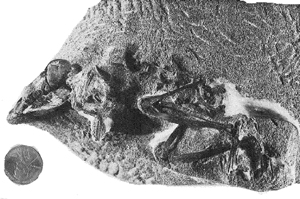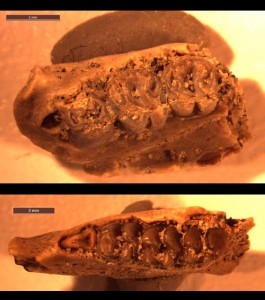Wedged between the end of finals, Christmas, and New Years are the required government year-end reports that are submitted to the Bureau of Land Management detailing all the research I have done on public lands in the United States under research permits I applied to during the year. It is a time to gather up all the fossils collected and hand them off to a public repository, so that everyone can come and study the fossils. The fossils remain in the public trust, and all the fossils I collected in 2013, will be within the collections of the Utah Field Museum of Natural History in Vernal, Utah.
For me it is a busy time adding the finishing touches on fossil preparation, madly identifying those strange fossils that eluded me all year, and to label everything. This year I conducted work in three different states (Colorado, Utah and Wyoming) which means that I had to complete three different reports. Although, most of the fossil discoveries this year came from Wyoming, in particular the Middle Eocene. Most of these fossils belong to a usual rodent called Protoptychus.
Protoptychus was first discovered in the Eocene deposits within the Uinta Basin of Utah by J. B. Hatcher who worked for Princeton University. The skull he found exhibited large orbits for the eyes, and a greatly expanded auditory bulla, which drew William B. Scott in 1895, to conclude a close similarity with Kangaroo-Rats (Dipodomys).
In 1937, Robert Wilson working at the Yale Peabody Museum came across a similar specimen from the Washakie Basin of Wyoming, which O.C. Marsh had collected during his expedition through Wyoming in 1872. Over a hundred years later, in 1973, while examining the original skull from Utah, John Wahlert noted that it exhibited a very large infraorbital foramen, a trait termed hystricomorphous. Hystricomorphous rodents include guinea pigs, chinchillas, and porcupines, and have a large opening below the orbit (eye socket) for the passage of the medial masseter muscle. Thus Protoptychus was suddenly thrust into the spot-light as a possible ancestor of this unusual group of rodents known primarily from North and South America. The number of specimens known of Protoptychus dramatically increased to 71 with the discovery of 69 specimens including two spectacular skeletons by William Turnbull in 1959. William Turnbull worked at the Field Museum of Natural History in Chicago, and it was not until 1991 that the specimens were prepared and a full description of the fossils was published. The fossils were found clustered together at a locality within the Washakie Basin of Wyoming. William Turnbull concluded that Protoptychus was in a group all its own, the Protoptychidae, between the primitive extinct, but common Ischyromyidae rodents of the Eocene and the more advanced Dipodidae (Gerbils and Jumping Mice). In fact, the enlarged intraorbital foramen is a convergent characteristic found also in the family Dipodidae. The enlarged eyes of Protoptychus indicate that it was nocturnal, like many of the members of the living Dipodidae. Wighart von Koenigswald in 2004 studied the enamel of Protoptychus and also concluded that Protoptychus was likely not a primitive hystricomorph rodent, retaining a primitive enamel structure. Most rodent workers place Protoptychus within its own family, although no phylogenetic analysis has been undertaken recently to review its relationship with other extinct rodents.
It was William Turnbull’s amazing locality that I relocated in the summer of 2013, discovering additional fossils of this prehistoric gerbil. Although we did not find additional skeletons, we did locate a number of additional lower and upper jaws of this rather unusual rodent (see figure below). I hope to return to the locality next year, and see what other types of mammals lived alongside Protoptychus during the Eocene. In particular, William Turnbull hypothesized that the environment was dry, with an open canopy forest. It will be interesting to see if this idea holds up to further paleontological and sedimentological analysis.
Any fossils I’ve mention were collected under the following BLM permits PA13-WY-205, COC75364, and UT12-001S, and I owe a special thank you to the great employees at the BLM, and their respective field offices.
Citations
Scott, W.B. 1895. Protoptychus hatcheri, a new rodent from the Uinta Eocene. Proceedings of the Academy of Natural Sciences of Philadephia, pp. 269-286.
Wilson, R.W. 1937. Two new Eocene rodents from the Green River Basin, Wyoming. American Journal of Science Series 5. 34:447-456.
Wahlert, J.H. 1973. Protoptychus, a hystricomorphous rodent from the Late Eocene of North America. Breviora, 479:1-14.
Turbull, W.D. 1991. Prototychus hatcheri Scott, 1895. The Mammalian Faunas of the Washakie Formation, Eocene Age, of Southern Wyoming Part II. The Adobetown Member, Middle Division (= Washakie B), Twka/2 (in Part). Feildiana, Geology New Series, 21(1421): 1033.
Koenigswald, W. 2004. Enamel Microstructure of Rodent Molars, Classification, and Parallelisms, with a Note on the Systematic Affiliation of the Enigmatic Eocene Rodent Protoptychus. Journal of Mammalian Evolution, 11(2):127-142.



